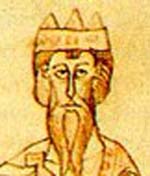Conrad II, Holy Roman Emperor
| Conrad II | |
|---|---|

Conrad II, depicted in the Chronicle of Ekkehard von Aura
|
|
| Holy Roman Emperor | |
| Reign | 26 March 1027 – 4 June 1039 |
| Coronation | 26 March 1027 Old St. Peter's Basilica, Rome |
| Predecessor | Henry II |
| Successor | Henry III |
|
King of Burgundy (formally King of Arles) |
|
| Reign | 6 September 1032 – 4 June 1039 |
| Predecessor | Rudolph III |
| Successor | Henry III |
|
King of Italy (formally King of the Lombards) |
|
| Reign | 31 March 1026 – 4 June 1039 |
| Coronation | March 31, 1026 Basilica of Sant'Ambrogio, Milan |
| Predecessor | Henry II |
| Successor | Henry III |
|
King of Germany (formally King of the Franks) |
|
| Reign | 8 September 1024 – 4 June 1039 |
| Coronation | 8 September 1024 Mainz Cathedral, Mainz |
| Predecessor | Henry II |
| Successor | Henry III |
| Born | 990 Speyer, Lower Lorraine, Holy Roman Empire |
| Died | 4 June 1039 (aged 49) Utrecht, Germany, Holy Roman Empire |
| Consort | Gisela of Swabia (1016–1039) |
| Issue |
Henry III, Holy Roman Emperor Matilda of Franconia |
| House | Salian |
| Father | Henry, Count of Speyer |
| Mother | Adelaide of Alsace |
| Religion | Roman Catholic |
Conrad II (c. 990 – 4 June 1039), also known as Conrad the Elder and Conrad the Salic, was Emperor of the Holy Roman Empire from 1027 until his death in 1039. The founder of the Salian dynasty of emperors, Conrad also served as King of Germany from 1024, King of Italy from 1026, and King of Burgundy from 1033.
The son of a mid-level nobleman in Franconia, Count Henry of Speyer and Adelaide of Alsace, he inherited the titles of count of Speyer and of Worms as an infant when his father died. Conrad extended his power beyond his inherited lands, receiving the favor of the princes of the Kingdom of Germany. When the Saxon-based Ottonian dynasty of emperors died off with the childless Emperor Henry II, Conrad was elected to succeed him as King in 1024 at the age of 34. Conrad founded his own dynasty of rulers, known as the Salian dynasty, which ruled the Holy Roman Empire for over a century.
Conrad continued the policies and achievements of the Ottonian Henry II regarding the Catholic Church and the affairs of Italy. Conrad continued to build the Church as a center for imperial power, preferring to appoint church bishops over secular lords to important posts across the Empire. Like Henry II before him, Conrad also continued a policy of benign neglect over Italy, especially for the city of Rome. His reign marked a high point of the medieval imperial rule and a relatively peaceful period for the Empire. Following the death of the childless King Rudolph III of Burgundy in 1032, Conrad claimed dominion over the Kingdom of Arles and incorporated it into the Empire. The three kingdoms (Germany, Italy, and Burgundy) formed the basis of the Empire as the "royal triad" (regna tria).
...
Wikipedia
